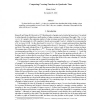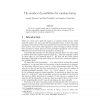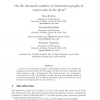4171 search results - page 16 / 835 » Choice numbers of graphs |
102
Voted
STOC
2001
ACM
16 years 1 days ago
2001
ACM
We show that for every fixed ? there is a quadratic time algorithm that decides whether a given graph has crossing number at most and, if this is the case, computes a drawing of t...
JCT
2008
14 years 11 months ago
2008
Let G be a regular graph and H a subgraph on the same vertex set. We give surprisingly compact formulas for the number of copies of H one expects to find in a random subgraph of G...
COMBINATORICS
2004
14 years 11 months ago
2004
Let G be the intersection graph of a finite family of convex sets obtained by translations of a fixed convex set in the plane. We show that every such graph with clique number k i...
CORR
2007
Springer
14 years 11 months ago
2007
Springer
A vertex k-labeling of graph G is distinguishing if the only automorphism that preserves the labels of G is the identity map. The distinguishing number of G, D(G), is the smallest...
107
click to vote
CPC
2004
14 years 11 months ago
2004
The strong chromatic number, S(G), of an n-vertex graph G is the smallest number k such that after adding kn/k-n isolated vertices to G and considering any partition of the vertic...



